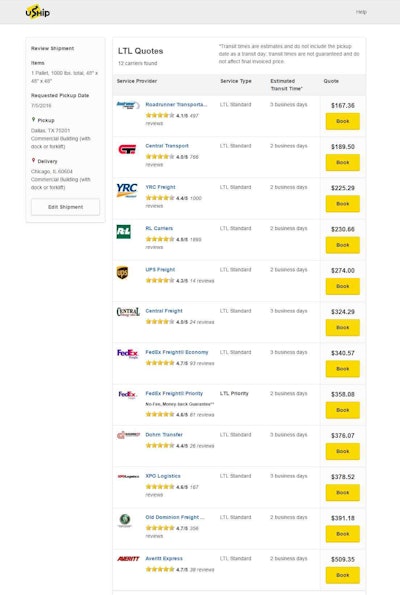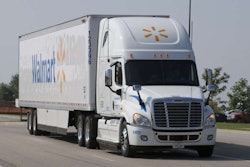
Large and mid-size carriers probably had the technology to provide shipment visibility. Small carriers, however, traditionally have lacked onboard computers and software needed to automate an electronic data interchange (EDI) process and stand on equal footing.
About 97 percent of active, DOT-registered carriers in the market today operate less than 20 trucks, according to RigDig BI Online, a trucking industry business intelligence tool from Randall-Reilly. To bridge the technology gap with larger competitors, small carriers had to answer check calls or manually update shipment status using their customers’ web portals.
Sharing pricing information was another challenge, as a lot of time and resources were tied up in phone calls, emails and faxes to respond to rate requests from customers and prospects.
New technologies are being used to iron out these wrinkles from freight transactions.
Total visibility
Today it is common for shippers and 3pls to require automated shipment track and trace capabilities from carriers, says Dave Halsema, executive vice president of MacroPoint.
Meeting this visibility requirement is no longer difficult as most drivers already have the technology necessary. Any connected device, even a flip phone, can be used to automate shipment tracking, he says.
Trailer tracking systems are also growing in demand. They give shippers and logistics providers seamless coverage of loads that change custody at international borders or are pulled by multiple carriers from origin to destination, says Henry Popplewell, president of SkyBitz, which supplies fleet tracking and management systems for trailer assets.
Popplewell says that more shippers, 3pls and brokers are investing in trailer assets and tracking systems, pointing to recent news that the nation’s largest online retailer, Amazon, now has a large trailer fleet.
 MacroPoint’s track and trace platform uses location data from mobile devices and back-office transportation management systems of carriers to give visibility to shippers and logistics firms.
MacroPoint’s track and trace platform uses location data from mobile devices and back-office transportation management systems of carriers to give visibility to shippers and logistics firms.MacroPoint is one of several companies that have track and trace platforms that capture location data from mobile devices and back-office transportation management systems of carriers. These companies aggregate data and give visibility to shippers and logistics firms.
The tracking process can be automated by using virtual “geofence” perimeters set up at arrival and departure locations on routes. When drivers enter or leave the designated spots, MacroPoint updates the status of shipments automatically, he says.
MacroPoint provides reports that show its customers which of their loads are ahead of schedule or behind schedule, among other exceptions, he says.
The tracking information can be fed to its customers with electronic data interchange (EDI), but it typically is sent directly to their transportation management systems (TMS) using a web service API.
This direct connection moves information faster and gives more frequent updates than EDI transactions. It also helps identify exceptions earlier on in the process, he adds.
Over the last three years, Halsema says MacroPoint has seen requests for its tracking platform increase 300 percent. It now does business with 84 of the top 100 freight brokers and 39 of the top 50 3pls. The company also works with nine of the 10 largest asset-based carriers by way of their brokerage divisions, he says.
McLeod Software, a developer of transportation management software for motor carriers and non-asset logistics firms, has an interface with MacroPoint and load tracking platforms from FourKites and 10-4 Systems, says Robert Brothers, director of product development.
More of its carrier customers are being asked to provide automated tracking data to their own customers through these providers, and Brothers says their ultimate goal is to give shippers and brokers visibility to trucks that are available to solicit capacity for spot-market transactions.
“That is the next step of the platforms they are trying to build,” he says.
Carriers can already post available equipment to load boards, but this can be a manual process and does not give the shipping community visibility to current location for more accurate and reliable freight matching.
TMW Systems, a provider of TMS software for asset and non-asset transportation companies, sees an opportunity to participate in this next evolution of load board functionality, says Brad Young, TMW’s principal of brokerage, asset light and 3pl divisions.
“The availability of resources is the hard part to get, but that is what we have,” he says. Dispatch and load planning information is in the TMW software that carriers use, and it could be shared with third parties automatically to identify when and where trucks will be available, he explains.
Automated pricing
Perhaps a greater challenge than shipment visibility is getting instant and reliable pricing information from carriers, particularly for spot market transactions.
Online marketplaces such as Expedia.com are widely used to search for and book hotel reservations and airline tickets. Now, a number of companies offer a similar experience for booking truckload and less-than-truckload shipments.
 uShip’s LTL marketplace obtains rates directly from carriers’ IT systems to give instant quotes to shippers.
uShip’s LTL marketplace obtains rates directly from carriers’ IT systems to give instant quotes to shippers.Some companies that have developed online sites that give instant pricing and booking features for shipments have freight brokerage authority to manage these transactions all the way from pickup to delivery.
Others have websites that remove the middleman altogether to connect shippers directly to carriers that provide instantly bookable quotes.
Last year, uShip created the latter type of online marketplace for less-than-truckload shipments. Shippers that use the site get instant rate quotes after entering a few parameters about their freight. The quotes come from as many as 35 major LTL carriers that uShip has agreements with, all of which share their pricing information to the site.
Carriers that use uShip’s web service API can change price quotes by day of week, by equipment type and other factors depending on how they choose to set up and automate the exchange of information with the marketplace.
The incentive for carriers that use the site is to gain access to shippers they would normally not market themselves to directly, says Dick Metzler, chief marketing officer of uShip.
Currently, 350,000 small-to-medium-sized business shippers are registered on uShip, many of which are merchants that sell their larger-than-parcel products through Amazon and eBay.
More than half of the shippers’ transactions on uShip are conducted using mobile devices to run their businesses on the go by eliminating phone calls, faxes and texts to arrange transportation. Tracking information for shipments is available on the site as well, as it comes in electronically from carriers.
Compared to the first quarter of 2015 when the site was in its infancy, uShip has seen an increase in revenue by 228 percent, he says. The revenue comes from shippers who pay a match fee; the service is free for LTL carriers.
Some new services also make it possible for fleets to automatically provide rates to the TMS systems used by their customers and prospects.
Sunset Pacific Transportation, a 135-truck carrier based in Chino, Calif., is now using a pricing engine API from Project44 to automate communications with shippers and brokers looking for spot quotes.
The company consolidates parcels and less-than-truckload shipments into truckloads outbound from California to locations nationwide. Its return trips to California are full truckload moves.
The API directs rates from Sunset Pacific’s transportation management system into the TMS systems of its shipper and broker customers. Sunset Pacific also uses the API in its corporate website to present rates to customers and prospects through an instant search tool, says Josh Craig, president and chief operating officer.
The impact of ELDs
Companies that purchase transportation are gearing up for a capacity shortage from the electronic logging device (ELD) mandate, making visibility to pricing and other data more critical as the Dec., 2017, enforcement deadline approaches.
Industry studies show that 53 percent of carriers currently have electronic logging devices. This leaves 47 percent of carriers without the technology, and studies show 43 percent of brokers have no knowledge of the current usage of electronic logs among their carriers.
 Barton Logistics uses business intelligence to predict the impact from ELD mandate on its traffic lanes.
Barton Logistics uses business intelligence to predict the impact from ELD mandate on its traffic lanes.Not knowing which carriers use ELDs exposes shippers and logistics companies to the risk of losing capacity as carriers implement ELDs. As a result, some carriers may suddenly not be able to sustain contract rates as they begin to fully comply with hours-of-service regulations.
Criss Wilson, vice president of operations of Barton Logistics, believes that rates are already moving to an unsustainable level as the industry ramps up to meet the ELD mandate. Last year, rates were in the favor of carriers, but they have softened considerably this year.
“The ELD mandate will only compound the problem,” he says.
Barton Logistics is a non-asset transportation company based in Medina, Texas, that contracts with owner operators and carriers to offer shipper customers a virtual fleet of 100 trucks and trailers.
As proof of a looming capacity shortage, Wilson points to the sudden spike in trucking company bankruptcies in the first quarter of 2016, as tracked by Avondale Partners. The 3,585 bankruptcies are nearly as much as the entire year of 2015.
Wilson has mined Barton Logistics’ data, and industry data, to determine that drivers can legally run between 80,000 and 110,000 miles a year. Drivers that do not run electronic logs can run between 140,000 and 150,000 miles a year, he says.
By running legal for 110,000 miles a year, drivers would have to earn $.50 cents a mile in pay to make what he believes is a sustainable income of $60,000 a year, he says. Research by the American Transportation Research Institute shows the average operating cost — excluding driver wages — is $0.69 per mile. Adding this to the sustainable wage of $0.50 a mile equals the break-even point for carriers running electronic logs: $1.19 per mile, he says.
Barton Logistics uses its software systems to identify lanes where contract rates need to hold steady so that the company, and its carriers, can prepare for a conversion to electronic logs, he says.
“It is essential for me to not exaggerate the problem by creating contract rates that are unsustainable for drivers,” he says.
These and other insights are becoming common as all parties involved in freight transactions are moving to greater connectivity and visibility.











